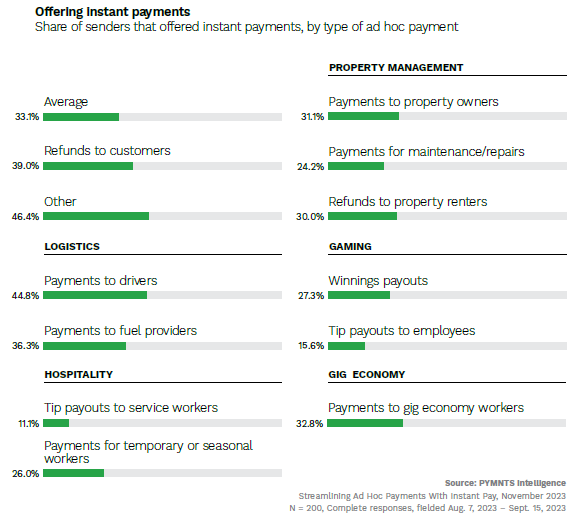Nearly 40% of Gig Economy Ad Hoc Transactions Sent via Instant Payments

Although ad hoc payments make up just 24% of accounts payable (AP) volume, they hold significant importance in various industry operations. In fact, these irregular payments, executed outside regular invoicing and payroll processes, are integral to operational efficiency.
But despite their importance, ad hoc payments are often considered an annoyance to enterprise operations. It’s a problem that instant payment methods can help solve, per a recent PYMNTS Intelligence report, offering a streamlined approach for both senders and recipients.
The report, “Streamlining Ad Hoc Payments with Instant Pay,” done in collaboration with Ingo Money, highlights that older use cases, such as gig economy companies, leverage instant payment methods the most. In fact, while on average, instant payments represent 27% of ad hoc payment transactions for senders in general, this share rises to nearly 40% in the gig economy.
This implies that “ad hoc payments are more central to their business — and partially explaining why this industry is most likely to use instant pay already,” per the report. Additionally, one-third of senders offered instant payments to gig employees.
The maturity of instant payment usage also varies across industries. Gaming companies, for example, rely more on non-instant methods for employee tip payouts. On the other hand, the hospitality industry is equally likely to make payments to PayPal accounts using instant methods. Overall, instant payments represent 27% of ad hoc transactions for enterprise senders, amounting to a volume of $14.4 million for companies with more than $1 billion in revenue.

One of the significant challenges associated with ad hoc payments is the costs involved. The report highlights that 22% of senders consider costs to be a major issue. However, digital instant payment solutions can help streamline the payment process and lower costs. It is the reason why enterprises are advised to take advantage of instant pay solutions to reduce the burden of ad hoc payments.
The report reveals that close to half of all senders already pay fees when using instant payments, indicating a willingness to invest in these services. This highlights the demand for instant payments and suggests that senders are interested in expanding their use of instant payment methods in the future.
Additionally, improving customer relationships is a critical factor for senders, with 80% believing that receivers are satisfied with current ad hoc solutions. However, one-third of senders aim to enhance customer satisfaction by adding new ad hoc payment solutions. Offering instant payments can be a game-changer in this regard, as 96% of senders using instant payments report that it improves customer satisfaction.
In essence, the frequency of instant payments in ad hoc transactions hinges on the maturity of instant payment usage. But significant progress is still required to increase widespread instant payment adoption in the U.S., according to David Watson, CEO of The Clearing House.
“In terms of the [faster payment] capabilities we can offer, we’re at about a seven. In terms of the take up, the use and the explosion of those payments, we’re at about a one or two,” Watson told PYMNTS CEO Karen Webster in a recent interview. “It’s a long journey to change an infrastructure and a settlement model.”
However, he emphasized that specific areas addressing unmet customer needs, like earned wage access and ad hoc payments, will be key factors driving “the momentum and scale for instant payments” moving forward.
“Instant payments settlement is the future, and it will be, de facto, the way to settle transactions cheaply, with certainty and with transparency,” Watson said.
